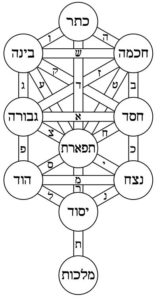Purim is a deeply mystical holiday. In fact, Megillat Esther literally means “revealing the hidden”. While God is not explicitly mentioned anywhere in the Scroll, His fingerprints can be found all over it. In the same way, the Megillah is imbued with tremendous hidden wisdom. That it has a total of 10 chapters is the first clue, and if you read carefully, you will find that just about every Sefirah is mentioned!
 The first Sefirah is Keter, the great “Crown” of God, and the first chapter of the Megillah is all about highlighting the greatness of Achashverosh’s crown and kingdom. Our Sages taught that Achashverosh wished to dress in the vestments of the kohen gadol, to “crown” himself as a king of the Jews (Megillah 12a). As is well-known, it was also taught that every time the Megillah refers to “the king” without a name, it is secretly referring to the King, to God. In Kabbalah, Keter always refers to Willpower (Ratzon), since the starting point of any endeavour is the will to do it. Everything begins with a will, and the universe began with God’s Will to create it, setting all of history in motion. Similarly, in the first chapter of the Megillah we find that Queen Vashti refuses to do the will of Achashverosh, thus setting the whole Purim story in motion.
The first Sefirah is Keter, the great “Crown” of God, and the first chapter of the Megillah is all about highlighting the greatness of Achashverosh’s crown and kingdom. Our Sages taught that Achashverosh wished to dress in the vestments of the kohen gadol, to “crown” himself as a king of the Jews (Megillah 12a). As is well-known, it was also taught that every time the Megillah refers to “the king” without a name, it is secretly referring to the King, to God. In Kabbalah, Keter always refers to Willpower (Ratzon), since the starting point of any endeavour is the will to do it. Everything begins with a will, and the universe began with God’s Will to create it, setting all of history in motion. Similarly, in the first chapter of the Megillah we find that Queen Vashti refuses to do the will of Achashverosh, thus setting the whole Purim story in motion.
The second Sefirah is Chokhmah, and the second chapter begins by introducing us to Mordechai, the paragon of a chakham, a Jewish sage. In Kabbalah, Chokhmah is also called Abba, the “father”, and we are told that Mordechai plays the role of an adopted father for the orphaned Esther. The third Sefirah is Binah, and the third chapter begins by introducing Haman, a master manipulator who knew how to twist people’s binah, “understanding”. Our Sages asked (Chullin 139b): where is Haman alluded to in the Torah? They answered that he is found in the words hamin ha’etz, “from the Tree”, referring to the Tree of Knowledge in the Garden of Eden (Genesis 3:11) Our Sages associate Haman with the Tree of Knowledge, the consumption of which brought evil into the world. According to one Kabbalistic view, the Tree of Life is associated with Chokhmah, while the Tree of Knowledge is associated with Binah, hence the mystical connection to Haman. It goes deeper.
In Chapter 3, we read how Haman became absolutely enraged when Mordechai refused to bow to him (Esther 3:5). The Zohar (II, 243a) teaches that each of the Ten Sefirot has a counterpart in the Sitra Achra, the “other side”, the realm of evil. The counterparts to Keter, Chokhmah, and Binah are referred to as Smoke (Tnana), Fire (Esha), and Blackness (Ukam). The Zohar teaches that the evil manifestation of Binah is anger! Anger comes from a lack of understanding, or from an improper or twisted understanding of events. In the “Binah” chapter of the Megillah, we are shown how Haman represents the evil side of Binah, the rage that leads to his downfall, and to the victory of the Jews. Haman is ultimately hanged on a “tree” (עץ) of 50 cubits, alluding to the mystical Nun Sha’arei Binah, the 50 Gates of Understanding.
After Binah, there is a hidden Sefirah called Da’at, “Knowledge”, though we never enumerate it among the Ten. Fittingly, the fourth chapter begins with the words u’Mordechai yada’a, “and Mordechai knew…” The actual fourth Sefirah is Chessed, God’s lovingkindness. In the fourth chapter we read how the Jews responded to the evil decree placed upon them with “fasting, weeping, wailing, sack, and ashes…” (4:3) These actions aroused God’s Chessed, allowing the evil decree to be annulled up above in the Heavens. Mordechai, through his divine inspiration, knew this and affirmed without doubt that “relief and salvation” will come to the Jews one way or another (4:14).
In the fifth chapter, Esther comes before “the king” for judgement, Din, the inner aspect of the fifth Sefirah, Gevurah. Esther asks for the king and Haman to join her for a “wine party”. The mention of wine is not coincidental, as red wine is always symbolic of Gevurah in Kabbalah. (In fact, there is a custom to add a few drops of water [Chessed] into the Kiddush wine to “temper” some of the Gevurah.) Gevurah also means “restraint”, and we find that, for once, Haman was able to restrain himself (5:10). The chapter concludes with Haman setting up the gallows upon which he hopes to execute Mordechai, another manifestation of Gevurah.
Chapter 6 of the Megillah is the turning point, when Haman is ridiculed and the truth hits him in the face: “If Mordechai, before whom you have begun to fall, is of Jewish stock, you will not overcome him; you will fall before him to your ruin.” (6:13) Recall that the sixth Sefirah is Tiferet, and is associated with emet, “truth”. In the seventh chapter, Haman is defeated and hanged on the very gallows he set up for Mordechai. This isn’t surprising since the seventh Sefirah is Netzach, “Victory”. The eighth chapter reveals the splendour—Hod, the eighth Sefirah—of the Jews, to whom was given “light and joy and happiness and prestige.” (8:16) We read that many gentiles converted to Judaism, too, becoming Yehudim (יהודים), which shares a root with Hod (הוד).
Everything comes full circle in Chapter 9, where we reach our Yesod, “Foundation”. The ten sons of Haman are killed, representing the ten counter-Sefirot of the Sitra Achra, noted above. The Jews have attained complete salvation, and Mordechai and Esther then establish the Purim holiday for future generations to commemorate. Just as Achashverosh had initially established (יסד, yisad) at his feast that there were no restrictions on drinking and feasting (1:8), at the end Mordechai and Esther establish the Purim feast for Israel.
Finally, the Megillah ends with a short tenth chapter of only three verses. In the same way that the tenth Sefirah, Malkhut, is always described as being small and “empty”, the small tenth chapter provides only a short conclusion. We see Achashverosh exercise his kingship, Malkhut, by implementing new taxes and running great campaigns. Mordechai attains a level of Malkhut, too, in becoming mishneh lamelekh, “second to the king”, in the inner circle of royalty.
 There is one more major mystical allusion in the Megillah worth pointing out. Why does the Megillah frequently reiterate that the events are taking place in Shushan HaBirah, “Susa the Capital”? Why is this so important to know? On a mystical level, it is alluding to a deeply Kabbalistic concept. The Zohar’s first passage begins with the symbolism of a thirteen-petalled rose. The rose has white and red petals, representing the opposing forces of Chessed and Gevurah. God tempered these forces in creating this perfectly-balanced cosmos. Concealed within the rose is the light of Creation, and the power of God’s salvation. The “Rose of Creation” is a shoshanah (שושנה) of beriah (בריה or בריאה), an anagram of Shushan HaBirah (שושן הבירה)! The setting of Purim is supposed to once more remind us of the hidden cosmic mysteries embedded within the Megillah for us to unravel.
There is one more major mystical allusion in the Megillah worth pointing out. Why does the Megillah frequently reiterate that the events are taking place in Shushan HaBirah, “Susa the Capital”? Why is this so important to know? On a mystical level, it is alluding to a deeply Kabbalistic concept. The Zohar’s first passage begins with the symbolism of a thirteen-petalled rose. The rose has white and red petals, representing the opposing forces of Chessed and Gevurah. God tempered these forces in creating this perfectly-balanced cosmos. Concealed within the rose is the light of Creation, and the power of God’s salvation. The “Rose of Creation” is a shoshanah (שושנה) of beriah (בריה or בריאה), an anagram of Shushan HaBirah (שושן הבירה)! The setting of Purim is supposed to once more remind us of the hidden cosmic mysteries embedded within the Megillah for us to unravel.
This ties right in to the custom of singing Shoshanat Ya’akov after the conclusion of the Megillah, for the Zohar compares the people of Israel to the same red and white thirteen-petalled rose. Best of all, for those who like gematria, the value of shoshanah (שושנה) is 661, equal to Esther (אסתר)! Esther herself is like the white- and red-petalled rose, and she is described in the Megillah as possessing chen v’chessed, both the grace of the left (red) pillar of the Sefirot, and the lovingkindness of the right (white) pillar.
Chag Purim Sameach!

Pingback: Secrets of Purim | Mayim Achronim